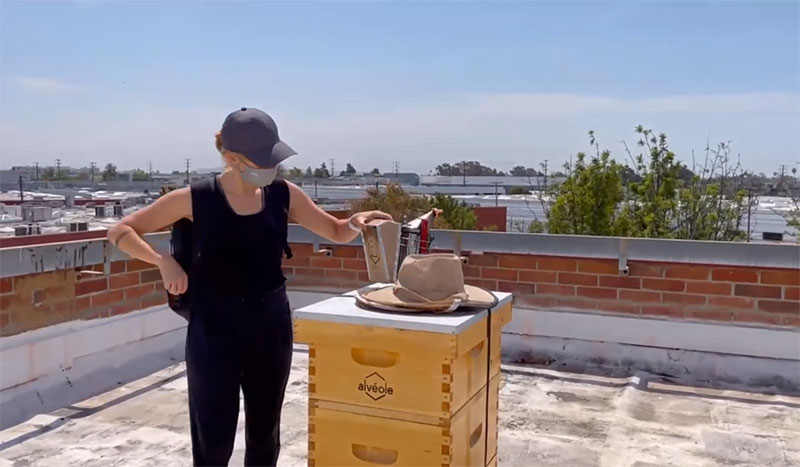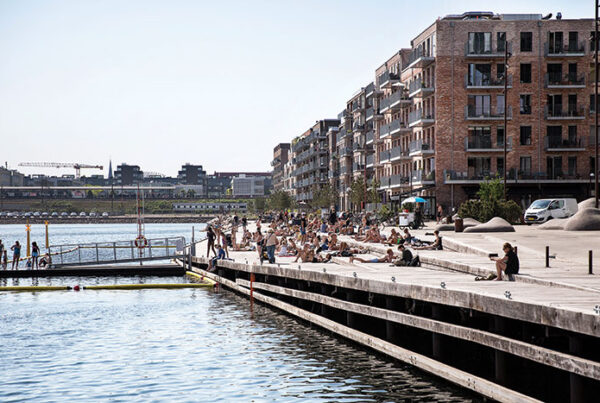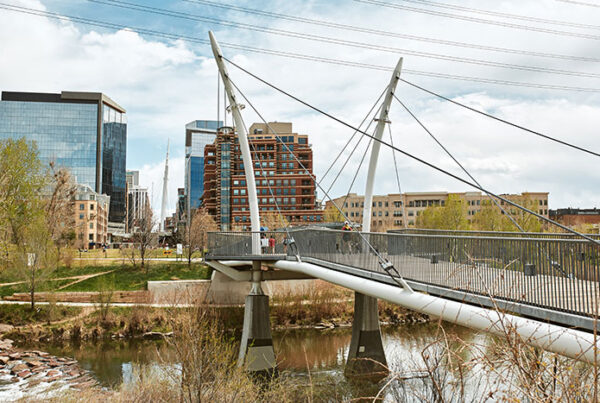This summer, ULI Los Angeles presented “The Buzz on Bees & Real Estate: Why Biodiversity Matters,” a webinar that convened panelists to discuss the value of integrating biodiversity into real estate through urban beekeeping. The speakers, who navigate the benefits and challenges of incorporating beehives into real estate properties, examined how hives can contribute to the growing movement of bees and other pollinators in urban settings.
“It’s really unique because it showcases and demonstrates how we can utilize our assets to have a really positive impact,” panelist Vaishali Sampat, director of sustainability and corporate social responsibility at Kilroy Realty, said at the webinar. “A lot of our ESG [environmental, social, and governance] is focused on mitigating negative impact, so this is really different in that way.”
A recording of the webinar is available at Knowledge Finder. | More ULI Los Angeles events.

(Los Angeles Sanitation & Environment)
The Role of Biodiversity in Urban Real Estate
Efforts to mitigate urban biodiversity loss are essential for real estate members working to increase their property value and minimize their ecological footprint. However, the potential for real estate to actively contribute to biodiversity is becoming more apparent. These contributions are expected to significantly affect the long-term value of real estate by supporting ecosystem services that advance adaptation to climate change and resilience planning in the industry.
Restoration ecology, sustainable landscaping, pollinator pockets, biophilic design, and organic waste recycling are just a few steps the real estate industry can take to increase biodiversity. Honeybees and other pollinators can contribute significantly to agricultural systems and ecosystem health, making urban beekeeping an effective way to promote biodiversity in cities.
“Native and nontoxic landscaping, soil health, and pest management and sustainable beekeeping, carefully executed with a goal of biodiversity enhancement in mind, can be very beneficial for biodiversity and help us to be more resilient to natural disasters and climate change,” said Peggy Nguyen, environmental supervisor for the city of Los Angeles and panel moderator.
Los Angeles hopes to promote biodiversity in the urban environment following the City Council’s adoption in 2017 of the Biodiversity Motion. One element of that was creating a customized biodiversity index, through which the city plans to improve methods of measuring biodiversity, identifying solutions, and engaging institutions, communities, and individuals in enhancing the city’s biodiversity. Resources provided by the city include an ecological landscaping portal, a listing of native plants, and opportunities for native plant landscapes to get certified as wildlife habitats.
Supporting biodiversity and ecosystem health can reduce the urban heat island effect, reduce greenhouse gas emissions, and improve stormwater management and air quality. As climate change continues to threaten the built and natural environment alike, it is essential that buildings be used efficiently. Vacant rooftops, terraces, and outdoor common spaces are beginning to be transformed into sources of thriving biodiversity through the introduction of pollinators and native plants.

Urban beekeeping company Avéole on site in Southern California.
The Business of Beekeeping
Urban beekeeping company Avéole is leading this optimization of space with a mission to reconnect people and nature in cities. The company assesses buildings for suitable beehive locations, provides all maintenance and hive management with a professional beekeeper, packages honey, and holds educational workshops for building stakeholders. With beekeeping projects extending to schools, businesses, and residential properties, beehives are sparking connections across the board.
“It’s a really special way to connect not only to the natural world, but also to the place where you work or live and have just another element of connection to that place,” said Carmen Atwater, beekeeping team manager at Avéole in Southern California.
Establishing safe and fully functioning beehives supports biodiversity and sparks conversations about the natural environment. For people working and living in cities, promoting biodiversity can seem like a distant concern. Bees are a tool that can be used to foster community relations and get people engaged and involved in caring about biodiversity in urban settings where it is not prevalent.
“When we’re talking about things like biodiversity, pollination, and the restoration of the habitat and planet, bees are a really powerful tool in order to start that conversation and get people interested,” said Shelby Schulman, beekeeping team regional U.S. manager at Avéole.
Getting individuals to look past the fear of bees is one of the biggest hurdles. Avéole has found that sharing its work, creating educational opportunities, and helping people strengthen relationships with beekeepers has allowed individuals over time at its properties to reach a greater comfort level with bees.

(Avéole)
Site Selection
Since starting the conversation about beekeeping projects back in 2019 during an annual sustainability presentation, CommonWealth Partners has already set up 15 beehives across seven of its properties. Kilroy Real Estate also found urban beehive projects to be a simple and not-cost-prohibitive way of furthering its ESG goals for biodiversity. Kilroy began integrating its eight beehives into its Washington and California properties in 2017, following the introduction of its biodiversity policy in 2016.
Many factors went into assessing the eligibility of sites. Selection of a site takes into consideration the proximity of the beehives to people, equipment, and the ground level. Insurance coverage, risk management, budgeting, and compliance with urban codes and laws also must be considered.
Other environmental tie-ins that supported the health and success of urban beehives were also considered. Among the most influential aspects of urban beekeeping programs is that successfully introduction of bees in urban settings encourages and demands further biodiversity measures. Beehives require green spaces with pollinator plants, native vegetation, and greener landscaping practices that also enhance the built environment. Urban beehives are only one aspect of promoting biodiversity: bringing bees into cities involves not just creating pollinator habitats, but also establishing natural corridors and fostering the growth of environmental systems.

Kilroy’s site selection process.
“Being that we weren’t the first to do this helps as well,” Sampat noted in discussing Kilroy’s process of site assessment. As urban beekeeping becomes more widespread, real estate members find that having more sites to use as a model facilitates the process.
Once the physical and environmental requirements are met, stakeholder buy-in is needed. One of the most appealing features of urban beehives is the hands-off aspect since the professionals handle the bees, which helps with buy-in from timid tenants, property owners and managers, and the engineering team.
“Bees haven’t had the best reputation before, and as time goes on and the awareness grows, we’re seeing that the buy-in is easier,” Sampat said.
Though beekeeping in urban settings is not a new idea, it is not particularly common yet. As more properties integrate beehives into their outdoor spaces, the level of comfort with the practice is beginning to improve. Regardless of whether tenants are looking to take tours up to the rooftop beehives or keep their distance, promoting awareness and communication on the topic has been effective in getting people excited about bees.

CommonWealth Partners’ tenant engagement activities for Earth Day.
Employee and Tenant Engagement
The natural fear of bees is usually a hurdle to introducing beehives. Regarding overcoming that fear, Jessica Loeper, director of sustainability at CommonWealth Partners, noted, “[Introducing bees] has created a community, more so than we ever imagined.” Like many companies beginning to implement these projects, members of the real estate industry are beginning to see that bees not only serve as a catalyst for biodiversity, but also foster employee, tenant, and community engagement.
“The bees are here and creating a community of bee enthusiasts,” Loeper said.
Internal newsletters, beekeeping sessions, and online sources for live bee statistics have helped spark engagement that is only growing in enthusiasm. Promoting buy-in also includes ensuring on-site beekeeper visits every three weeks, 100 jars of honey per hive at the end of the season, and workshops for stakeholder engagement.
CommonWealth is also bringing together its employees through the distribution of its very own rooftop honey and hosting tasting competitions for honeys from buildings across its portfolio. Kilroy also found ways to engage employees who are not on site to experience the beehives firsthand: at its virtual 2020 holiday party, Kilroy distributed to employees its packaged honey plus other ingredients for a virtual cocktail-making event.
While most honeybees do not present a significant risk for stings, looking past that initial fear is an element of recognizing the potential they hold for transforming urban real estate. Bees offer an opportunity to bring about lasting, widespread benefits for biodiversity, resilience planning, and positive working and living environments in cities. The importance of biodiversity is growing in the real estate sector, and bees offer the perfect place to start.




